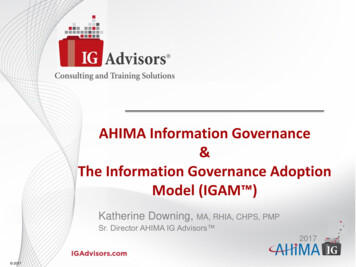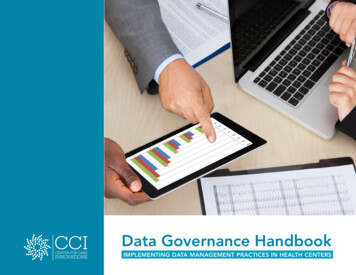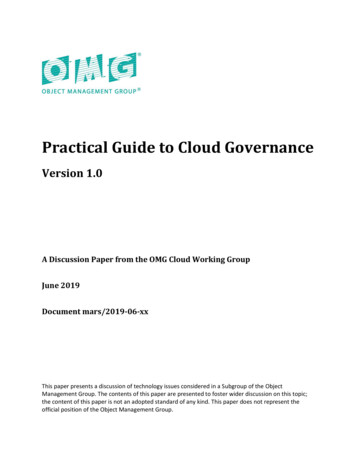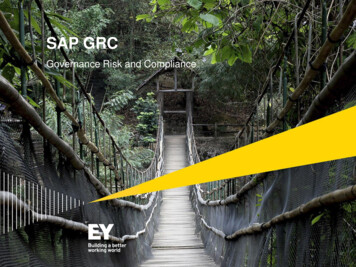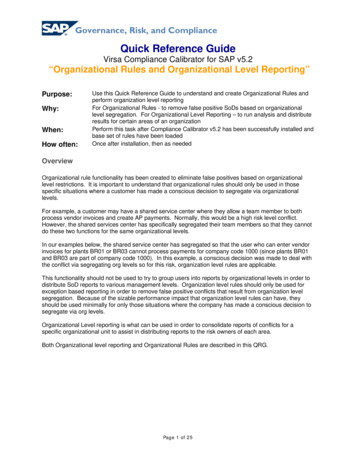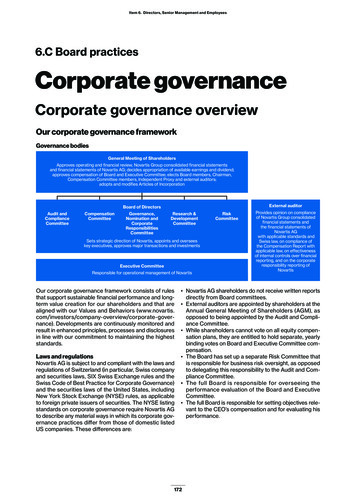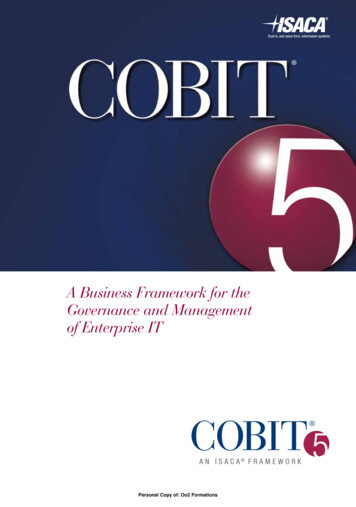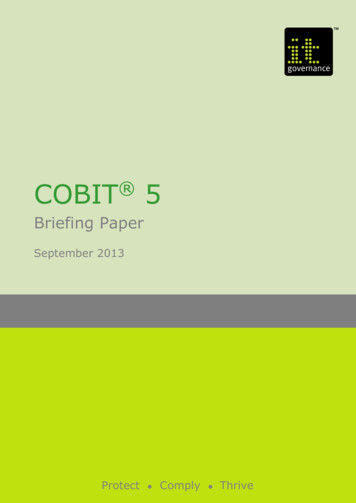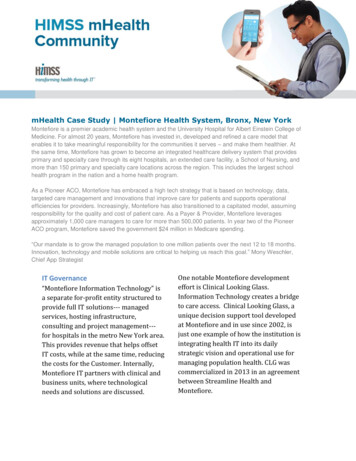
Transcription
mHealth Case Study Montefiore Health System, Bronx, New YorkMontefiore is a premier academic health system and the University Hospital for Albert Einstein College ofMedicine. For almost 20 years, Montefiore has invested in, developed and refined a care model thatenables it to take meaningful responsibility for the communities it serves – and make them healthier. Atthe same time, Montefiore has grown to become an integrated healthcare delivery system that providesprimary and specialty care through its eight hospitals, an extended care facility, a School of Nursing, andmore than 150 primary and specialty care locations across the region. This includes the largest schoolhealth program in the nation and a home health program.As a Pioneer ACO, Montefiore has embraced a high tech strategy that is based on technology, data,targeted care management and innovations that improve care for patients and supports operationalefficiencies for providers. Increasingly, Montefiore has also transitioned to a capitated model, assumingresponsibility for the quality and cost of patient care. As a Payer & Provider, Montefiore leveragesapproximately 1,000 care managers to care for more than 500,000 patients. In year two of the PioneerACO program, Montefiore saved the government 24 million in Medicare spending.“Our mandate is to grow the managed population to one million patients over the next 12 to 18 months.Innovation, technology and mobile solutions are critical to helping us reach this goal.” Mony Weschler,Chief App StrategistIT Governance“Montefiore Information Technology” isa separate for-profit entity structured toprovide full IT solutions--- managedservices, hosting infrastructure,consulting and project management--for hospitals in the metro New York area.This provides revenue that helps offsetIT costs, while at the same time, reducingthe costs for the Customer. Internally,Montefiore IT partners with clinical andbusiness units, where technologicalneeds and solutions are discussed.One notable Montefiore developmenteffort is Clinical Looking Glass.Information Technology creates a bridgeto care access. Clinical Looking Glass, aunique decision support tool developedat Montefiore and in use since 2002, isjust one example of how the institution isintegrating health IT into its dailystrategic vision and operational use formanaging population health. CLG wascommercialized in 2013 in an agreementbetween Streamline Health andMontefiore.
Clinical Looking Glass (CLG) is a uniquedecision support tool that:·Turbo-charges QI through its unprecedentedability to analyze healthcare data;·Democratizes the analytic process byallowing the clinical team to navigate clinicaldatabases when and how they want withoutIT staff involvement; and·Transforms the culture, excites the staff, andenables award winning changes in caredelivery·Unique temporal operators permit rapid onthe fly longitudinal analysesCLG is an integral tool at Montefiore bymonitoring each patient’s temporaltrajectory experience. More than 800users have been trained in CLG and it hassupported over 230 QualityImprovement initiatives, 50 IRB projects,resident education and physiciancontinuing medical education. CLG hasalso led to the publication of 40 peerreviewed papers including, “Best ClinicalPractice Article,” Journal of the AmericanCollege of Radiology, 2010. In addition tothe 800 users, it is part of the curriculumat Albert Einstein College of Medicine forall residents."Organizations are starting tounderstand the value of technology andits role in improving care, reducing costsand supporting the business. AtMontefiore, there are no areas in ourorganization that I can think of that aretechnology-free. Our strength is that wehave leadership who understand theimportance of investing in innovation sothat we can continue to improve ourpatients’ experiences and have betteroutcomes within a financially sustainablemodel. Recently, we’ve been introducingmore technologies to help us bettermanage patients when they are not inthe hospital; tele-health and mobilesolutions are key to achieving this goaland overall improving populationhealth.” Jack Wolf, CIO MontefioreA strategy and process for incorporatinginnovation and new technologies:Montefiore has a long-standing processwhere IT is reviewed by clinical,technical and financial experts todetermine if technology solutions alignwith operational and strategic needs ofthe health system. What’s unique is thatthis Innovations Team assesses eachtechnology, interfaces with incubators,accelerators, and has quickly become theentry point for technology into the healthsystem.
Identifying, evaluating and adopting thelatest innovative technologies is criticalto ensuring that Montefiore continues togrow and succeed as an integratedhealthcare delivery system. Eachtechnology will be evaluated for theability to:·Improve outcomes·Improve quality·Improve patient satisfaction·Improve provider efficacies·Reduce unnecessary admissions·Reduce costs·Function as a sustainable modelThe goal is that once a technology issuccessfully vetted through the processand returns with positive findings, thesolution will be funded and implementedthroughout the organization.The process when applied to mobilityand apps has helped Montefiore decidewhen to acquire an existing solution andwhen to develop. Montefiore has builtapps internally, and when necessary,partners with vendors and developmentfirms. Patient focused apps undergo amarketing and branding review forcontinuity across platforms and usecases.Current apps commissioned and codeveloped by Montefiore include:·Barcode medication administration andcharting·Remote phlebotomy·CLG Mobile viewer·Radiation oncology nutrition·Mobile media captureMontefiore IT supports approximately4,000 Bring Your Own Devices and 1,500corporate issued devices – Theorganization employs a mobile devicemanagement system (MDM) to monitorand secure these devices. The MDMsolution also plays a key role in broadlydistributing applications to providersand staff. Montefiore employs anenterprise mobile management solution,to better manage devices and apps, sothat corporate apps and PHI areprotected while not limiting the user’spersonal experience with their device. Ageo fence is also in place so that certainapps only function when the device is oncampus and connected to the securewireless network.Technology in PlaceOne can see a shift to mobile OrientedTechnology’s employed across theOrganization. We are investing in IOSand Android based solutions:·Cardiocom for heart-failure program·Enterprise PACS with Remote ViewingCapabilities on mobile devices·Airstrip-OB for mobile access to fetalstrips· Airstrip One – mobile EKG access· Smart pumps· Smart beds·Wireless vitals· Philips Intellivue MX40·Stinger Enovate workstations on wheelswith batteries that can be swapped.·Mobile Phlebotomy – Realtime draws and labelsprinted at the bed side
Pilots & Technologies being evaluated:· Cureatr secure & structured providercommunications· Alvio spirometry gameified changing theway COPD is identified and treated· Sense Health engaging patients toimprove medication and appointmentadherence· Zephyr studying the pressure ulcers· Tele-medicine robotics for inter-campusconsults·Tele-health combining video visits andphysician guided remote diagnosis toreduce ED visits and unnecessaryreadmissions. Tyto Health:Changes in Care Models and Role ofTechnologyMobile technology creates theopportunity for new care models andnew workflows.“Mobile devices/mobile apps are thefuture terminal; both IT and vendorshave to get on board with supportingthese form factors as user demand isonly increasing.” --- Marc Grayson,Montefiore IT, Product Manager, AppleProduct Support and DevelopmentMontefiore’s partnership with AirStriphas been fundamental to how we haveused technology to improve access toclinical data. The deployment of AirstripOB enables the OB teams to review allfetal monitoring data on a tablet, eventhough the delivery rooms are milesapart. As one of the first sites to deploythe Airstrip One platform we had toreview and redesign the entire EKGworkflow. This started with the cartsthat had to be upgraded with wirelesscapabilities to the mobile devices theclinicians required. The new workflowprovides access to the EKG’s on averagein 90 seconds. The care team can nowreview current and historical EKG fromanywhere which helps the STEMI patientget to the cath lab faster.
Future assessments of the platforminclude:· EHR integration· Lab integration· Clinical Decision Support (CDS) for STsegment elevation resulting from myocardialinfarction (STEMI). Early warning broadcastalerts provide the ability for the cardiologistteam to be informed of a STEMI arriving.·Assessment of “door to balloon times” formonitored patients·Assessment of patients monitored with orwithout AirStrip ONE ·Integration of early STEMI with emergencyresponders for CDSMuch of Montefiore’s patient populationlives within one of the poorest countiesof the country, and access to smartphones or Internet can be a challenge.Therefore, Montefiore is looking toprovide tele-health solutions tosupplement home health, specifically forheart failure and post discharge patients.We are looking to partner with a solutionprovider that can manage the technologywhile feeding us the data in a commonformat. Typical kits would include bloodpressure, glucometers, scales, smartpillbox, temperature and a smart deviceto transfer the data and enable a videovisit.Another challenge is the lack of a uniquepatient identifier. Having a unique IDwould make certain that we are sourcinginformation for the right patients. Thiswould significantly improve healthcaresystem efficiencies as well as bringsignificant financial stability to thehealthcare system.Improving OutcomesMontefiore is participating in the Centersfor Medicare and Medicaid AmbientWarning and Response Evaluation(AWARE) Pilot during a three-yearperiod, Mayo Clinic will train 1,440existing ICU caregivers in four diversehospital systems to use new healthinformation technologies to manage ICUpatient care. Montefiore is working withPhilips and Mayo to transmitphysiological data, lab results and otherclinical data to the secure cloud basedsystem. More than 100 iPads weredistributed to ICU faculty to ensure easyaccess to AWARE. Adding the apps thatprovide access to the EMR, PACS, EKG’sand analytics is in progress. Theopportunity is in creating a better userexperience by sharing the patientcontext between apps and building acommon user interface for mobility.Barriers & ResolutionA significant barrier to improvingpopulation health is the fact that NewYork is an opt-in state with regard tohealth information exchanges. There is aneed for a tiered approach to a masterpatient index, which integrates with aRHIO and then up to national levelexchange.As a member and grant recipient ofPILOT health tech NYC, we partneredwith Sense Health on a text messageclinical trial. Sense Health provides theability to capture all patients in thesystem by providing a month of prepopulated communication with patients,from a pre-approved database of
messages. These messages are deliveredthrough SMS technology, relievingproviders from having to generate newcontent. It also provides a workflow forcase managers to follow-up with neededactions like scheduling follow-upappointments and medication refills.HIPAA compliance is enforced on behalfof providers.In a pilot study, we saw a 40% increasein appointment adherence and a 12%increase in medication adherence amonghigh-need patients. Combined with ourcare management support; these highutilizers were also 21% more motivated,26% more confident, and 22% moreknowledgeable about the lifestylechanges recommended for their health.An IRB study will be conducted over thenext year to monitor the success of thisplatform and to evaluate itssustainability.Sample patient testimonial “Thetexting program helped me feel likepeople cared about me. I didn’t feel aslonely. It reminded me what wasimportant and why I was workingtowards my goals.”What’s Next?Today, Weschler steers amultidisciplinary Innovation Committeethat reviews and identifies innovationsto solve existing challenges. TheInnovations Committee is the first steptowards Montefiore’s goal to launch itsown Innovation Center, which wouldreview opportunities for creating newhealthcare solutions by taking equity incompanies looking to test and pilot newtechnologies. This presents anopportunity for Montefiore to continueto use the latest technology to bettercare for our patients, while diversifyingrevenue streams that will help sustainoperations and drive efficiencies.Acknowledgements: Dr. David Scher, Isaac Altschuller, Mony Weschler, Steve Berman,Marc Grayson, Jack Wolf, Tracy Gurrisi, and Sue CipollaThe inclusion of an organization name, product, or service in this document should not beconstrued as a HIMSS endorsement of such organization, product, or service, nor is thefailure to include an organization name, product, or service to be construed as disapproval.For more information visit http://www.himss.org/mhealth 2014 Healthcare Information and Management Systems Society (HIMSS)
Montefiore IT partners with clinical and business units, where technological needs and solutions are discussed. One notable Montefiore development effort is Clinical Looking Glass. Information Technology creates a bridge to care access. Clinical Looking Glass, a unique decision support tool developed

